
Let’s say you’re climbing the performance chart that reflects your ad campaigns. After all that hard work and PPC strategizing you put toward improving your performance grade, how steep is the climb looking? Is it an easy or tough climb?
Some of us come off as natural all-star rock climbers, while others are left frigid, timid, and stuck to the crevices of the wall.
What’s the secret? As with most things: proper training. And if you don’t have any, don’t worry — there’s still hope.
We here at KlientBoost have partnered up with HubSpot to bring you some rock solid tactics that you can use to get a grip on the whole PPC thing.
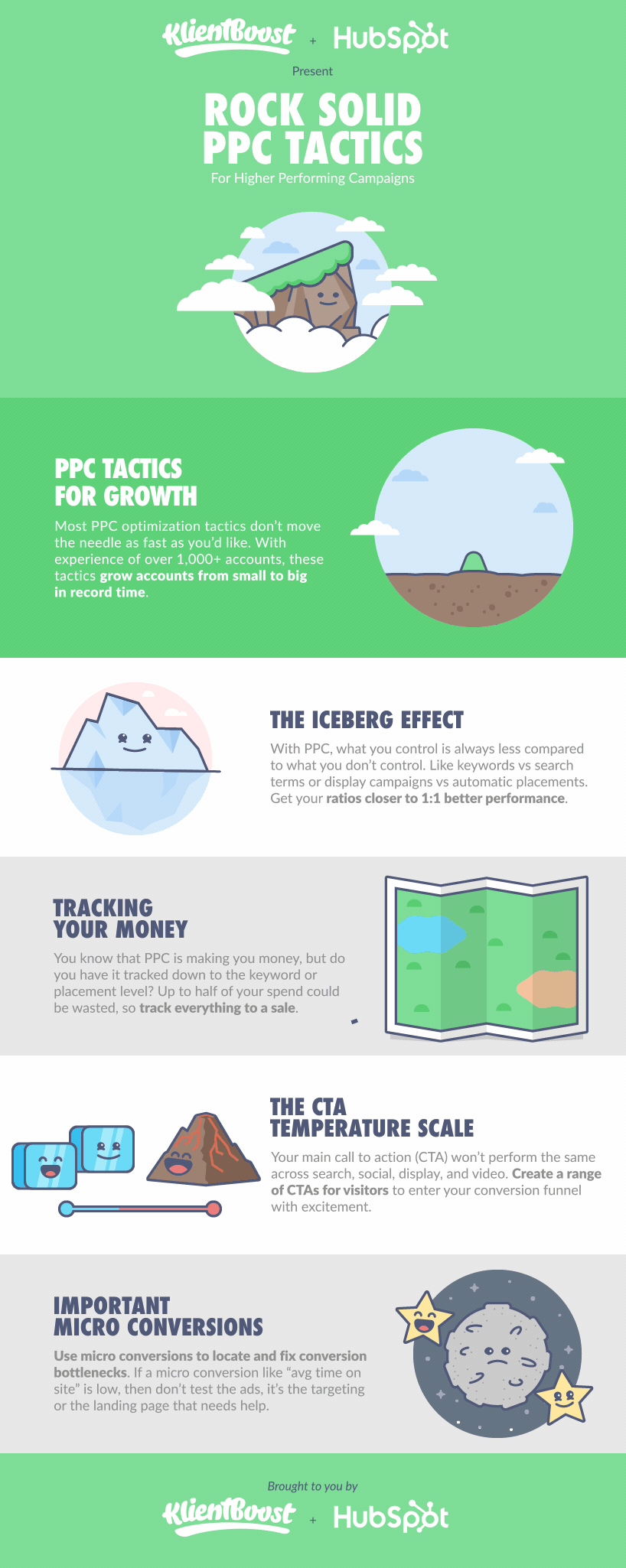
The Iceberg Effect: Gain More Control Over Your PPC Campaign
The search terms that you end up paying for and the keywords that you’re actually targeting don’t always line up the way you want.
Too often we see the “Iceberg Effect” in action, where miscellaneous search terms below the surface are tacked onto keywords that we think are working properly in our ad campaigns. It gives us an unhealthy search to keyword ratio that might look something like this:
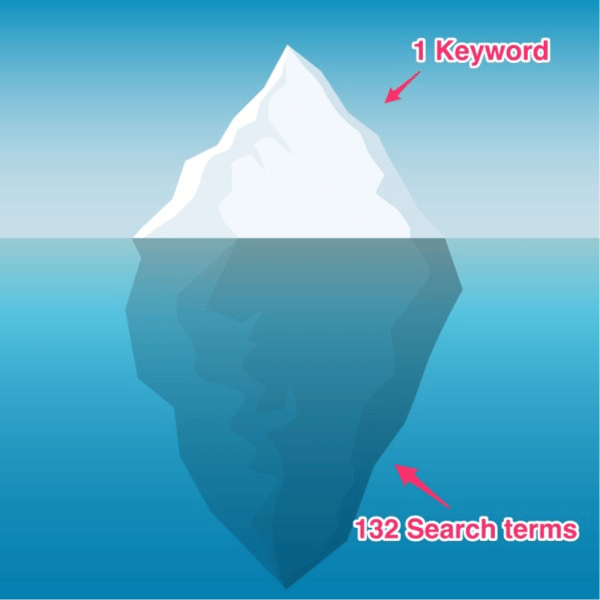
Not being in control of all those search terms? Not ideal. With a search term to keyword discrepancy ratio of 132:1, it can be challenging to continually improve your clickthrough rates and lower your cost-per-click averages.
How do you gain control of this icy situation? We use something called Single Keyword Ad Groups (SKAGs) to shoot for a 1:1 ratio of search terms to keywords, allowing for more control over the entire ad group.
Here’s what a non-SKAGs search term report might look like:
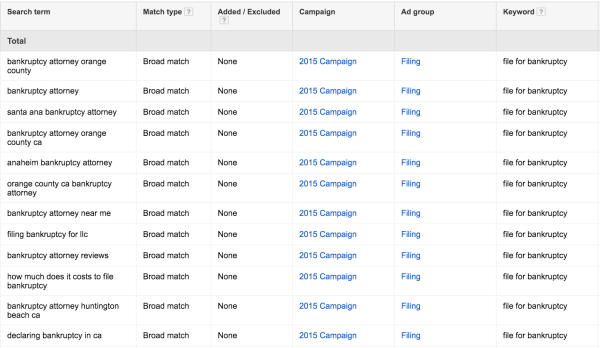
It’s not that any of these search terms are bad, it’s that each search term has a different conversion and sales rate. And by keeping them as search terms and not turning them into keywords, you will never be able to control them to take your PPC campaigns to the next level.
So what does a search term report look like if we use this granular PPC tactic and use SKAGs?
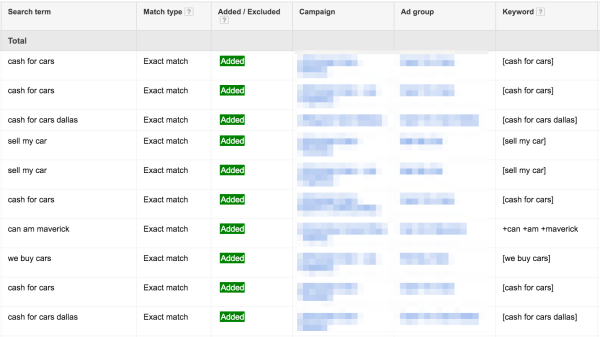
Everything in the search term column matches the keyword column. With the SKAGs tactic, you can get super granular and isolate one variable at a time, which means you have more control over your entire PPC account.
And with the ability to lower your search term to keyword ratio to 1:1, you can take it one step further and do the same from keyword to ad. When this happens, you’re able to increase your clickthrough rate, which in turn:
Increases your quality score
Decreases your cost-per-click
Increases your impression share
Improves your average position
Value Tracking: Keeping Tabs on Conversions vs. Sales
With your PPC tactics now upgraded, your PPC campaigns should be driving up conversion volumes and making you more money. But do you know which keywords, audiences, or placements are actually making you money?
If you don’t track the components of your campaign and attribute them to your sales, you might be missing out on where to focus your efforts. By implementing Google’s ValueTrack parameters you can automatically track data within URLs when your visitors convert.
When you tie your hidden field sales tracking back to your CRM, you can find out specific details about which leads are making you the revenue (doesn’t apply to ecommerce). Hidden form fields can reveal to you things that happen during a conversion, like which landing page URL your conversion came from, where the visitor is located, or what keyword they typed in.
You can also do this with manual UTM parameters. Here’s an example of how on the surface, you would think Keyword #1 is converting better:
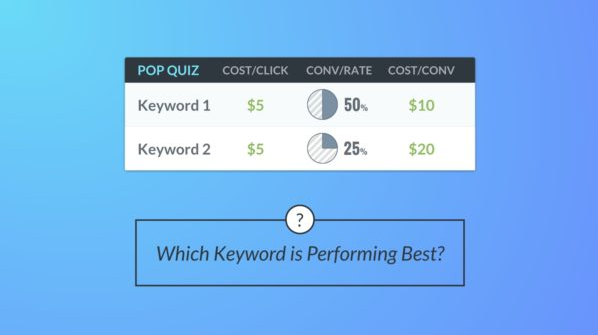
Keyword #1 has a lower cost-per-conversion.
Here’s an example of what hidden field sales tracking can reveal to you on a deeper level:

Now Keyword #2 looks better, right?
Although Keyword #1 has a lower cost-per-conversion, Keyword #2 has a much higher sales rate, which is making you more money. See the benefits of tracking the sale vs. the conversion?
Knowing these types of details can help you understand where you should be crediting your sales success, so you can be more aggressive in bidding on those keywords, audiences, or placements. With this PPC tactic, you can ease up your budget on the areas that aren’t contributing to sales, and allocate to the areas that are.
The CTA Thermometer: Gauging Visitor Intent on the Temperature Scale
Not all PPC visitors come through to your landing pages with the same conversion intent.
Typically, those that come through from display tend to be colder, while visitors that come in from search tend to be warmer. Here’s a visual we’ve learned works well across the multitude of client verticals we service:
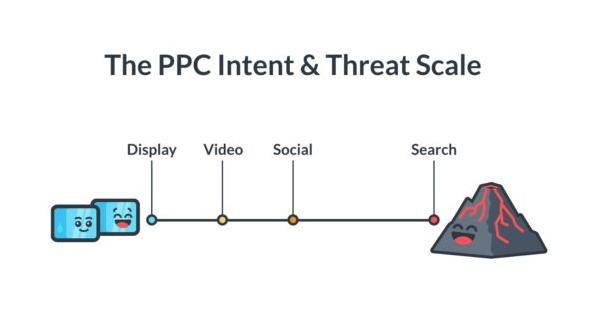
There’s a temperature scale that varies depending on visitor origin. Knowing where your visitors come from can help you immensely when it comes to matching your call-to-action with their temperature in the conversion funnel.
We recommend testing out various CTAs to match the intent temperature of your visitors — after all, a small CTA tweak could’ve made all the difference.
Here are some ideas to make your offer more relevant to your visitors:
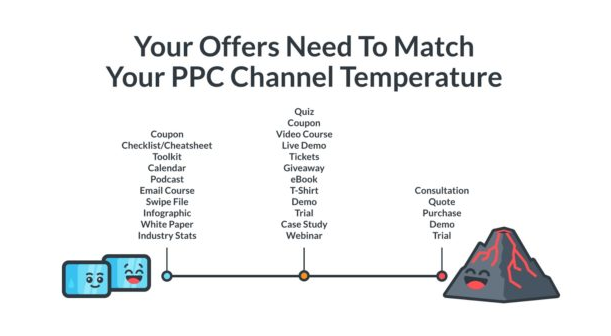 In short: the warmer your visitor’s intent the warmer the CTA can be. Traffic that comes in from the display network will likely respond to colder CTAs, since those visitors are in the awareness stage.
In short: the warmer your visitor’s intent the warmer the CTA can be. Traffic that comes in from the display network will likely respond to colder CTAs, since those visitors are in the awareness stage.
Micro PPC Conversions: Breaking Down the Larger Conversion Into Smaller Pieces
As you know, the more granular and detail-oriented you can get with you PPC campaigns, the more control you can have over the success of them.
When it comes to conversions, you can break down your larger macro conversion into micro conversions to figure out where your issues are.
An effective way to figure out which part of your PPC campaign is causing the conversion bottleneck is to analyze the micro conversions. Let’s say that you’re running some new Facebook campaigns but for some reason, no one is converting. If you knew, however, that visitors spend an average of four seconds on your site/landing page, then you know that your Facebook ad targeting may be off. Instead of thinking it’s the ad or landing page that needs some tweaking, it could be your targeting instead.
Here are some common types of micro conversions we use to analyze the path towards a conversion:
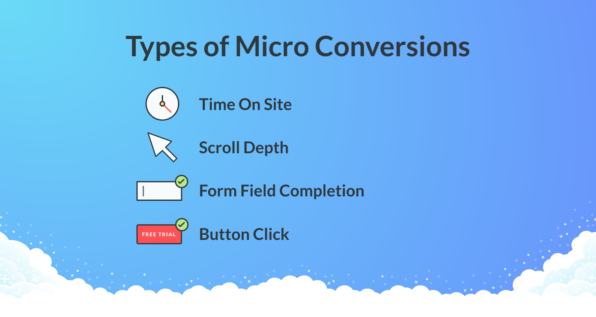
What can each of these common micro conversions tell you about your landing page? Let’s break it down:
Time On Site. How long are your visitors spending on your site? If the time is brief, the conversion issue doesn’t have to do with your landing page design. The issue is happening in an earlier stage, like in your ad campaign or your targeting options.
Scroll Depth. How far are your visitors scrolling down your landing page? If they aren’t scrolling down very far, maybe you need to have a shorter landing page where your CTA is above the fold. If they’re scrolling pretty deep, it might be a good opportunity to include additional (super legible) offer details toward the bottom of the page.
Form Field Completion. Are visitors abandoning your forms? If so, try testing out different formats and include a multi-step landing page with more form fields.
Button Click. Testing out different CTA button colors and copy may be the key to your larger conversion success.
By isolating micro conversions you can zero in on where exactly the conversion friction is located, which can help you alleviate the issues quickly and reach your larger conversion goal.
Closing Thoughts
Whether it’s addressing the Iceberg Effect, tracking your sales vs. conversions, testing CTA temperatures, or analyzing your micro PPC conversions, each of these PPC tactics can have a significantly positive impact on the performance of your campaigns.
And the best part, there’s a good chance your competitors don’t even know about them.
Now it’s your turn to up your PPC performance game. With these useful PPC tactics, you’ll be climbing your performance incline to the top with utmost ease.
What are your best PPC tips? Share them in the comments below.
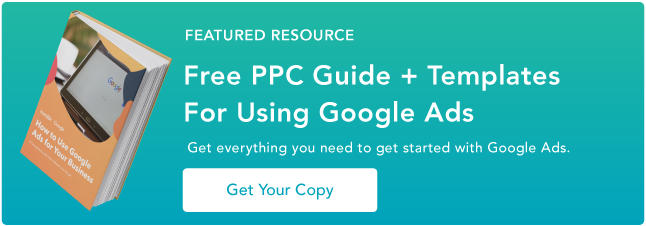
![]()

